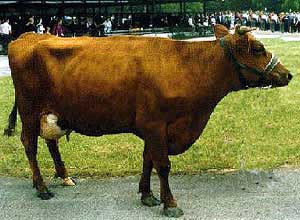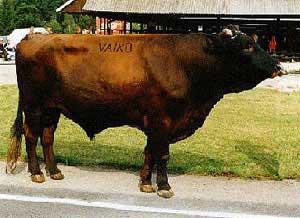Estonian Red Cattle
 In the middle of the 1800s the local Estonian cattle were crossed with the Angeln
breed. Later to improve the crosses Danish Red animals were used. The aim was to form
a breed with high milk yield and high fat content. The first Estonian Red animals
were entered in the herdbook in 1885.
In the middle of the 1800s the local Estonian cattle were crossed with the Angeln
breed. Later to improve the crosses Danish Red animals were used. The aim was to form
a breed with high milk yield and high fat content. The first Estonian Red animals
were entered in the herdbook in 1885.
The head is medium in size, with fairly short and narrow forehead. The neck is of medium size. The chest is often narrow and of medium depth. The withers and back are level; the rump is wide and of medium length. The legs are of medium length and correctly set. The skeleton is fairly strong. The udder is of medium size, glandular. Coat color is light or dark red; that of the bulls is darker. Body measurements (in cm) are: withers height 127.5, chest depth 70, chest width 45.5, oblique body length 157.9, heart girth 195.6, cannon bone girth 18.3. Better cows have a wide barrel with a solid skeleton and muscles. The live weight of calves at birth is 31-33 kg; cows weigh 450-550 kg (maximum 780 kg); mature bulls weight 800-900 kg (maximum 1000 kg). The milk yield of 164,900 evaluated cows was 3456 kg with 3.92% fat. The production of Estonian Red cattle at 77 breeding farms is as follows: average milk yield per cow 3784 kg, fat content 3.98%, protein content 3.30%. In 12 high producing herds the average milk yield per cow during a 305-day lactation amounts to 4127-5029 kg, and fat content is 3.90-4.18%. There are 25 record holders in these herds: including cow 5338 - 5th lactation, 9610 kg milk, 4.14% fat; cow 4519 - 7th lactation, 8554 kg of milk, 4.47% fat; cow 2431 - 2nd lactation, 7806 kg milk, 4.65% fat.
 Improvement of the Estonian Red cattle is being carried out by pure breeding and by
crossbreeding with the Danish Red and the Angeln. The new type with Angeln blood should
have the following performance: milk yield not less than 7000 kg with 4.0% fat, milking
rate 1.9 kg per minute, live weight of cows over 600 kg. According to the census the
total population of the Estonian Red breed in 1980 was 492,000. This breed accounts
for 63.3% of all cattle in Estonia.
Improvement of the Estonian Red cattle is being carried out by pure breeding and by
crossbreeding with the Danish Red and the Angeln. The new type with Angeln blood should
have the following performance: milk yield not less than 7000 kg with 4.0% fat, milking
rate 1.9 kg per minute, live weight of cows over 600 kg. According to the census the
total population of the Estonian Red breed in 1980 was 492,000. This breed accounts
for 63.3% of all cattle in Estonia.
Reference
Dmitriez, N.G. and Ernst, L.K. (1989) Animal Genetic Resources of the USSR. Animal Production and Health Paper Publ. by FAO, Rome, 517 pp.
